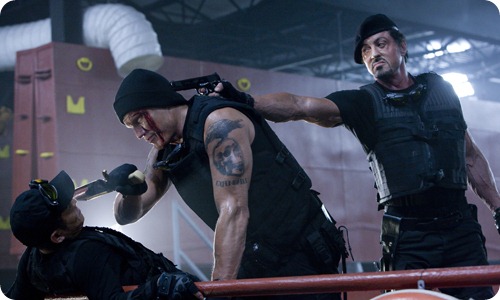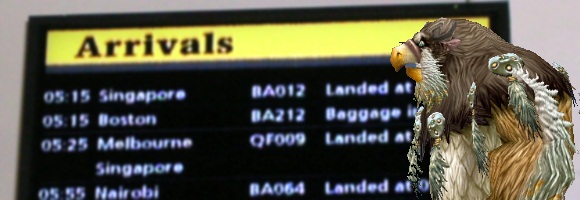This is a guest post by Blacksen of Blacksen’s End. Don’t forget to check out his blog!
I just saw The Expendables a couple of nights ago, and while not a particularly fantastic movie, there were a few good moments. The movie basically revolves around a team (called “the Expendables”) who undertake a mission to free an Island from a tyrannical General and the American investment puppeteers ordering him around.
The team consists of 4-5 skilled assassins (if you can call them that), all taking orders from Barney Ross (Sylvester Stallone’s character). While watching, I noticed that the movie was kind of like a World of Warcraft raid. The Expendables fought wave after wave of terrible soldiers (Sylvester Stallone ironically calls them “trash”). At points, they were just throwing out grenades and AoE’ing the trash down. Eventually, they would run into one of the Americans (which we could call a “boss”), and there would be a big battle around them. Throughout the movie, I noticed that Barney Ross had a lot of characteristics that matched my own raid leadership style. Even towards the end, Sylvester Stallone made a terrible “your mom” joke.
What other qualities that Barney had that would make him a good WoW raid leader?
Draw the line and stick to it. Without giving anything away, there are numerous instances in which Barney clearly draws a line. At the start of the movie, he draws the line for one of his team members. He essentially says “this is how much I’m going to tolerate,” and when that team member does cross the line, there are some real consequences.
A lot of World of Warcraft raider leaders don’t know how to do this (and I admit, I sometimes fail at enforcement). You must clearly identify the point in which someone isn’t adequate. Is it 8k DPS? 10k? 2 Malleable Goos? 5 Deathwhisperer ghosts? And when one of these does get crossed, you should be prepared to actually enforce the proposed consequences. If you tell everyone “we’ll be swapping you out the second time you get hit by Halion’s cutters,” then you should actually swap people out at the second time they get hit by cutters.

Keep your cool. Even amidst hundreds of bullets flying his way every second, Barney is still able to stay calm and make good decisions. He doesn’t get too angry, stressed, or upset, despite being in a very difficult situation. Being able to make decisions when things are very challenging and stressful is a critical part to effective raid leadership. Barney could have started to freak out and make rash decisions. Instead, he chose to stay cool, think things through, and make good calls.
Know how and when to change plans. Sometimes, things just aren’t working. For Barney, crap seemed to hit the fan all the time. Whether he’s just riding in a car with his friends and getting ambushed, or he’s trying to set up remote mines in the villa, things just never seem to go right. For both Barney and his second-in-command, it was critical to deviate from the plan and adapt to the situation. For raid leaders, there are several points in which you might also need to do this. If you don’t have a raid composition that’s going to complete a fight, it might be worth not trying (heroic Lich King without a disc priest, for example). There’s really not much of a point in attempting heroic Halion with 5 healers, so you might need to change plans.
If you’re trying a certain strategy and it just isn’t working, try something else. Heroic Halion was a good example for us: I was stubborn for a while and insisted that Halion be tanked at the wall while upstairs. We eventually found that it just wasn’t working, so we tried the “run through” strategy that we use now.
Stallone probably would have been more willing to change plans much earlier, as it was pretty obvious things weren’t going right.
Delegate to key players. For some raid leaders, it can be really tempting to try to micro-manage everything that’s going on. After all, most of us trust ourselves more than anyone else. By trying to control everything, you feel like there’s less room for other people to make an error in judgment. Usually, this mentality leads to poorer decisions and a more stressed raid leader. Barney clearly would have known that if he were a raid leader. Throughout the movie, he knows when there are times to delegate tasks for the rest of his crew. Sometimes, you just can’t do everything alone. More importantly, he knows which members would succeed better in certain areas.
At one point, the “short” team member was given a job in which his small stature would help him. By identifying the advantageous qualities of your key players, you can delegate them tasks in which they will truly shine.

Recruit a completely badass team. I’ve said it a hundred times, and I’ll say it again: the key to a successful progression guild is effective recruitment.
Barney would have died within the first 5 minutes of the movie without the support of his team. For raid leaders, this is also the case. Recruit badass players – you’ll need their support in order to free an Island from a tyrant… erm, I mean free Azeroth from Deathwing.


